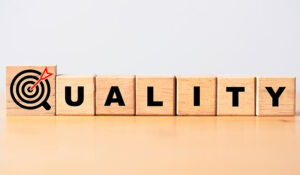Dick Bourke of Scorebuddy shares his definition of call centre productivity, before presenting his top tips on how to improve it.
Every company wants to be more productive. After all, if more is accomplished every day, profits increase, employee engagement swells, and positive customer experiences grow. It’s all about using your time wisely.
In the call centre, productivity is one of the greatest and most important challenges you’ll face. The more efficient your call centre agents, the lower your overhead costs and the higher your revenue. It’s that simple, but it’s not that easy.
Everything from increased customer demand to staff turnover can negatively affect call centre productivity. You have to stay on top of how your agents are performing daily if you want the best results. And understanding the precise meaning of call centre productivity is the first step.
What Is Call Centre Productivity?
In the simplest terms, productivity measures the amount of work accomplished over a specific period of time. Synonymous with output or efficiency, productivity is all about how quickly you accomplish your set tasks.
The Importance of Improving Agent Productivity
As a measurement, call centre productivity helps you determine if you’ve hired the right number of employees and if their work is a worthwhile return to your company. The reality is that 53% of employees give the minimum effort required and will leave quickly for even a slightly better offer, according to Gallup. So, ensuring agent productivity is critical to success.
Productive employees help make your company profitable while unproductive employees cost your company money. But beyond impacting company profitability, productive employees also improve morale, increase customer satisfaction, and produce a better company culture.
Call Centre Productivity and Customer Service
In particular, call centre productivity is tied hand-in-hand with positive customer experiences. That’s because the best customer experiences aren’t just based on high-quality service, but also on completing the service in a timely and efficient manner.
For example, a productive call centre agent would answer incoming calls quickly and solve customer problems in as few calls as possible, which directly correlates to increased customer satisfaction. The key to quality customer experiences is being quick and thorough, and that requires agent productivity.
How to Measure Call Centre Productivity
How do you know if your call centre is productive? You have to measure it.
Call Centre Productivity Formula
There is a very simple call centre productivity formula you can and should use to measure agent productivity across all customer service-related activities. It’s called occupancy rate, and it’s a measure of how much time your agents spend working on customer-related duties: answering calls, filling out forms related to calls, participating in training, etc.
By the Scorebuddy definition, the call centre productivity formula is:
Labour Productivity = (Total Output / Total Input) x 100
- Total Output refers to the amount of time your employee spends on actually achieving their goals. For example, you can count time spent speaking to customers and time spent performing required administrative duties.
- Total Input refers to the amount of time your employee has to spend—their daily work schedule.
For example, let’s say your call centre agent worked an eight-hour shift, 8 would be their total input for the day. Then, let’s say they spent 6.5 hours on the phone and performing work-related tasks. Their productivity would be:
6.5 / 8 = .8125 x 100 = 81.25% productive
This means that on a daily basis, 81% of your call centre agent’s time is spent doing their job, and 18.75% of their time is spent on non-work-related activities
Call Centre Productivity Metrics
Now, while the call centre productivity formula is a helpful tool for gaining an overall understanding of your employee’s productivity, it’s not as effective as breaking agent productivity down into specific goals.
To do that, consider the following call centre productivity metrics.
Abandonment Rate
(Abandoned Calls / Total Incoming Calls) x 100 = Abandonment Rate
Abandonment rate—call or live chat—can help you figure out how well your agents are handling customer interactions. A low rate can mean that your agents are getting to calls quickly and handling problems efficiently. A high rate might indicate dissatisfied customers and unproductive agents.
However, please note that this call centre productivity metric might not tell you a lot about the productivity of your individual agents, but it will give a solid view of your entire centre. If your average abandonment rate is too high overall, you can start to determine what’s causing the abandonment and how to fix it.
Average Handle Time
(Total Talk Time + After-Call Work Time) / Total Number of Calls = Average Handle Time
Average handle time refers to how long your agents spend on the phone or handling live chat with a customer. A super low number isn’t necessarily what you’re looking for because the agent needs enough time to handle the customer’s problem effectively.
However, a lower average handle time does indicate that your agents are taking more calls and being more productive.
The goal is to decrease average handle time while keeping up customer satisfaction to improve productivity. To do this, implement quality assurance software such as Scorebuddy to monitor call quality.
You should also focus on providing tools and training that improve how quickly your agents can respond to customers in a thorough manner.
Average Time in Queue
Total Caller Wait Time / Total Number of Calls = Average Time in Queue
Average time in queue looks at how long your customers spend waiting to talk to your agents. The higher this number, the longer your customers are waiting to get their problems solved, and the more likely they’re having a poor experience.
The shorter your wait time, the more efficient your agents are at handling calls, and the happier your customers.
The key is to look at average time in queue at the same time as you review the average time it takes your agents to answer the phone. The goal is to see if the wait time is due to agents moving too slowly to pick up the call or if other factors are involved.
First Call Resolution Rate
Total # of Resolved Calls on First Contact / Total # of Calls = First Call Resolution Rate
First call resolution is a great measure of agent productivity and effectiveness because it helps you determine how well your agents meet your customer’s needs during one interaction.
If a customer has to call back or chat multiple times, you’re losing productivity dealing with the same issue again and again. The lower your FCR rate, the more productive your call centre is.
Adherence Rate
[Actual Working Hours / (Standard Work Hours – Breaks)] x 100 = Adherence Rate
Adherence rate helps you determine how much of your agent’s time is actually spent performing their job.
- Actual working hours refer to when your agent is actually taking calls, responding to customers, and performing administrative functions.
- Standard work hours refer to how many hours a day they are paid to work.
- Breaks refer to lunch and other standard breaks.
For example, let’s say your employee is scheduled to work 8 hours a day with a 30-minute lunch break, but they are only taking calls for 7 hours. Their adherence rate would be [7 / (8 – .5)] x 100 = 93%. The lower this number, the worse your agent productivity.
Average After-Call Time
Total After-Call Time / Total Number of Calls = Average After-Call Time
How long your agents are on the phone or handling live chat isn’t the only indication of productivity. You also have to look at how long your agents spend doing after-call work, such as data entry, quality assurance, paperwork, etc. The goal is to decrease average after-call time while keeping up accuracy.
Cost per Call
Total Number of Calls / (Operating Costs + Labour Costs) = Cost per Call
Cost per call is another critical call centre productivity metric. It tells you how much it costs per call, including operating costs: facility rental, utilities, management overhead, computer equipment, etc.
The higher the cost per call, the more expensive your labour, which means the more productive your agents have to be to earn a profit.
Annual Turnover Rate
(Number of Employees Leaving / Total Number of Staff) x 100 = Turnover Rate
Annual turnover rate is a great indicator of productivity because new employees take a while to ramp up, which means they have lower productivity. New employees also cost more in terms of training, which can take away from productivity in the call centre. The lower your turnover rate, the more productive your contact centre overall.
10 Ways to Improve Call Centre Productivity
What can you do to improve your call centre productivity? It’s about engaging with your agents, addressing customer issues, and creating a more cohesive call centre.
1. Focus on Call Quality
Improving call centre productivity at the cost of call quality is exactly what you don’t want to do. Handling more calls poorly helps no one. Instead, you need to focus on improving productivity while keeping call quality high.
To do this, implement a scoring system such as Scorebuddy to rate each customer interaction based on criteria that match your goals: professionalism, accuracy, empathy, customer satisfaction, etc. The goal should be to improve call quality and productivity at the same time by implementing training and coaching as needed.
2. Engage Your Call Centre Agents
According to a Gallup State of the Local Workplace study, actively engaging your employees is key to productivity. Every year, there’s $7 trillion in lost productivity because 85% of employees are not engaged or are actively disengaged at work.
When you engage your call centre agents, you help them feel like a more valuable member of your call centre team, which in turn motivates them to do their job, resulting in more productive agents.
To engage your agents, give them ways to participate in the decision-making processes. You want to create a positive environment where your agents feel like they play a vital role in the company’s overall success.
You can do this by taking agent feedback, including them in the quality assurance process, and gaining their participation in all aspects of running the call centre.
3. Offer Flexibility
Flexible call centre setups can also increase productivity, according to 64% of global business leaders (Condeco reports). Offering flexibility can include options such as:
- Working Off-Site: 77% of employees report greater productivity outside the office.
- Working Alone: 86% of employees say they are more productive when working from home or alone.
The key to flexibility is offering agent autonomy. The more your agents feel like they have the trust and freedom to handle customers as they see fit, the more productive they’ll be. It will help you streamline the call centre workflow, bolster morale, and improve agent engagement.
4. Utilize Call Centre Software
92% of employees say that having technology that helps them do their job efficiently improves their work satisfaction, according to a study by Ultimate Software. Knowledge is power, and the more you use software in the call centre to track key metrics or provide more efficient customer solutions, the better.
With call centre quality assurance software, you also provide your agents with access to real-time metrics. What this does is help them understand how they’re performing so that they can make more informed decisions about their productivity.
For example, if your agents have access to information on customer wait time or call handle time, they can use that as motivation to improve their performance. The key is to use software such Scorebuddy for quality assurance compared to a spreadsheet or template—those can be slow and negatively impact your productivity.
5. Focus on Customer Flow
Few things can kill call centre productivity more quickly than poor workflow. Instead, you need to ensure that when calls and chats come into your call centre the traffic is distributed appropriately.
This means sending customers to the right teams and agents who are best suited to answering their problems and successfully resolving the interaction on first contact.
6. Connect Your Agents
Organizations that connect their employees can improve productivity by 20–25%, according to the McKinsey Global Institute. That’s because environment plays a huge role in agent productivity. If your agents feel like they are part of a team with the necessary support to do their job, they’ll be more productive.
7. Hire the Right Agents
Superior talent is up to eight times more productive than average employees, according to McKinsey. And a robust onboarding process can improve productivity by more than 70%, according to a study by Glassdoor.
The reality is that bringing on new employees is a long process that greatly impacts your overall call centre productivity. Instead, you want to focus on hiring the right agents and training them well from the very beginning. In this way, you reduce training costs, improve employee engagement, and build a more effective call centre team with everyone running at 100%.
8. Decrease Interruptions
Interruptions are one of the main reasons for lost productivity. That’s because, according to the University of California, Irvine, once you’re derailed from a task by an interruption, it will take you 23 minutes and 15 seconds to get back on track.
However, this doesn’t mean that you shouldn’t allow your agents to take breaks. A short break can help decrease agent stress, which can have a significant impact on productivity. The key is to schedule short breaks throughout the day and avoid idle breaks that eat up time but don’t decrease stress.
9. Create an Incentive Program
Agents respond well to rewards for a job well done. To motivate your agents to perform at their best, create a recognition program that offers rewards to top-performing employees. The idea is to increase employee satisfaction while also fostering personal growth and development—all of which will impact productivity and your bottom line.
69% of employees would work harder if they were recognized, according to Gallop, so follow these eight steps for creating an incentive program to get started.
10. Measure and Adjust
Finally, it’s essential that you regularly perform call centre quality assurance to see what you can do to improve. The more automated you can make this process, the better, because it won’t interfere with your overall productivity.
But even then, by continually monitoring and improving your call centre, you’ll reap the benefits in customer experience, customer loyalty, agent productivity, and ultimately, the bottom line.
Just make sure that your metrics are associated with your company’s goals while aligning with efficiency and effectiveness. In this way, you ensure that what you’re measuring and adjusting is wholly related to your performance.
Take Steps to Improve Call Centre Productivity Today

Dick Bourke
Your contact centre is the heart of your business, which means it’s essential to ensure that it’s running smoothly. To do this, you have to take a look at the metrics that most severely impact the quality of your call centre’s productivity and then do what is necessary to improve your processes and agents.
Much of your call centre productivity hinges on using the right technology, measuring the right metrics, hiring the right people, implementing the correct training, and continuously looking for ways to improve.
This blog post has been re-published by kind permission of Scorebuddy – View the Original Article
For more information about Scorebuddy - visit the Scorebuddy Website
Call Centre Helper is not responsible for the content of these guest blog posts. The opinions expressed in this article are those of the author, and do not necessarily reflect those of Call Centre Helper.
Author: Scorebuddy
Published On: 19th Feb 2020 - Last modified: 25th Feb 2022
Read more about - Guest Blogs, Scorebuddy






 Scorebuddy is quality assurance solution for scoring customer service calls, emails and web chat. It is a dedicated, stand-alone staff scoring system based in the cloud, requiring no integration.
Scorebuddy is quality assurance solution for scoring customer service calls, emails and web chat. It is a dedicated, stand-alone staff scoring system based in the cloud, requiring no integration. 









